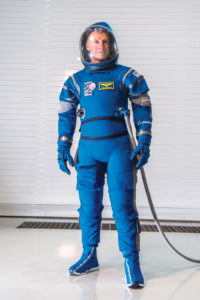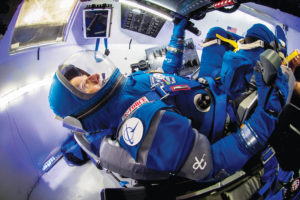
What does the well-appointed astronaut wear on a shuttle mission? That was the challenge for designers tasked with rethinking the spacesuits to be worn on the Boeing-built CST-100 Starliner that will launch in 2018 and be used for low-Earth orbit missions and trips to and from the International Space Station.
The new Starliner spacesuit, which will be worn by crewmembers during launch, ascent and re-entry, needed to be lighter weight and enable better mobility. The project team wanted a design that was as innovative as the new spacecraft itself, while being comfortable and even stylish.
The “Boeing Blue” suit checks off all those boxes. Manufactured by The David Clark Co., Worcester, Mass., with input from the Boeing team, it meets NASA requirements for safety and functionality. At about 20 pounds, it is approximately 40 percent lighter and much more flexible than its predecessors.
The suit is made of layers of material including a non-commercial Gore-Tex® that allows water vapor, but not air, to pass through, making it cooler without sacrificing safety. A second layer that protects and gives the suit its shape is made of a lightweight Nomex® material that is fire-retardant and abrasion resistant.
Instead of the old-fashioned “bubble helmet” attached to a thick neck ring, the suit incorporates  a soft helmet that includes a communications cap assembly for a continuous connection to ground and space crews, and a large polycarbonate visor for better peripheral vision.
a soft helmet that includes a communications cap assembly for a continuous connection to ground and space crews, and a large polycarbonate visor for better peripheral vision.
Comfort and accessibility were built in wherever possible. Lightweight leather gloves are enabled for tablets and touch screens. Breathable leg pockets hold a survival kit and personal items.
 TEXTILES.ORG
TEXTILES.ORG


